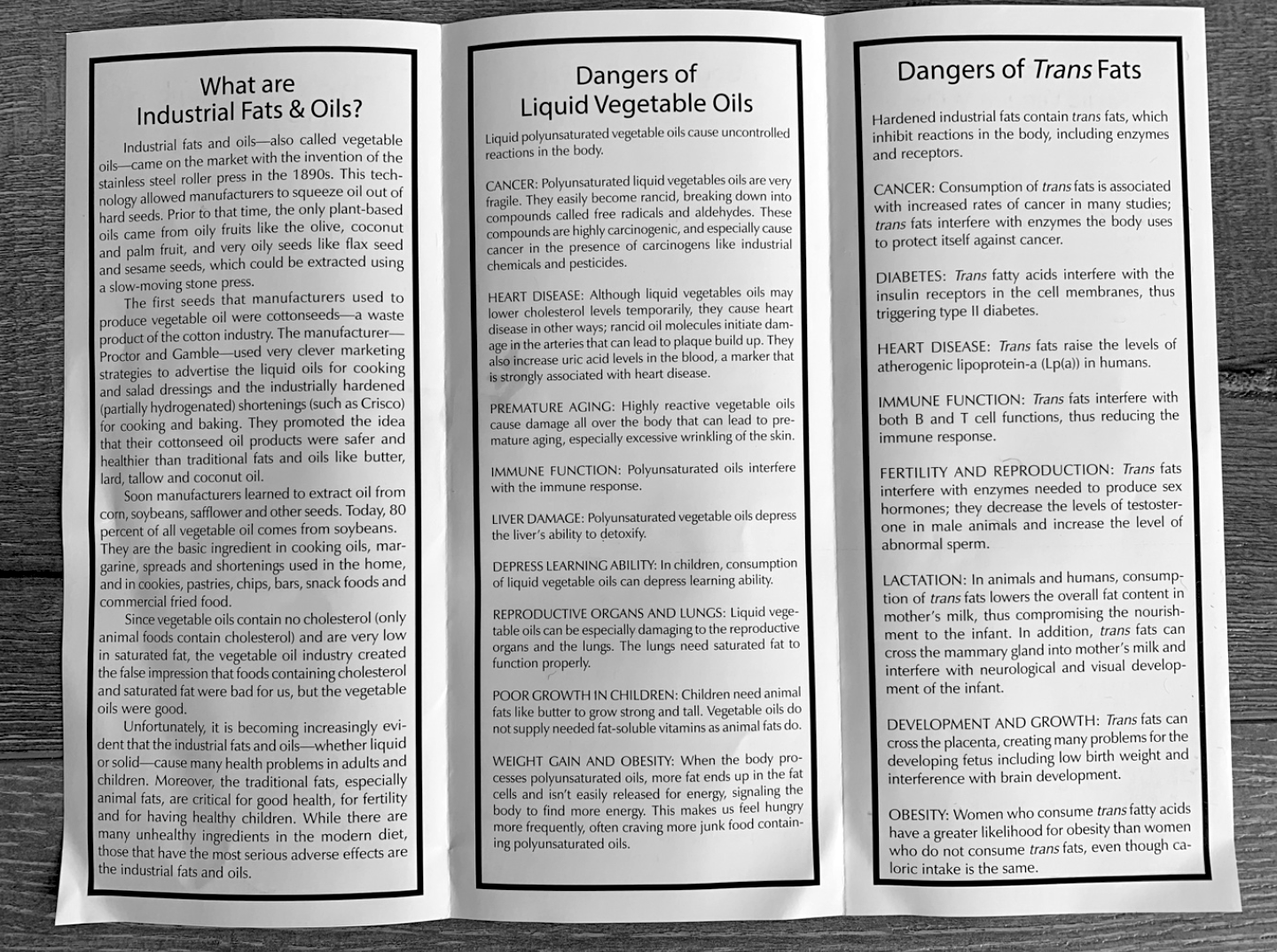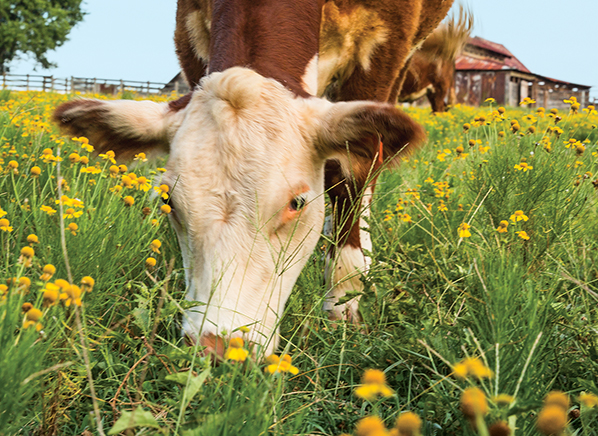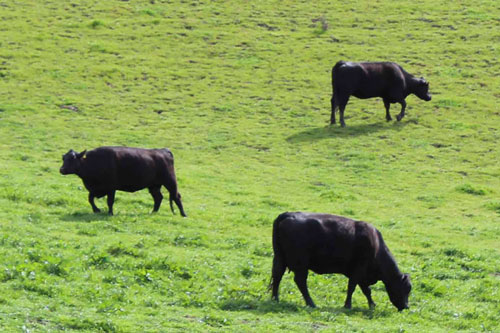The Due Diligence Series: 3 Questions to Ask when Buying Butter
Guest User
In the third blog in my due diligence series, I’m focusing the spotlight on butter. I’m frequently asked what brand or brands of butter I use or recommend. I’ve devoted my life over the past decade, and have made a living out of, researching and seeking out the best quality food, drinks, personal care products and household cleaning products. For what we put in, on and breathe into our bodies directly and profoundly impacts our health. To not be concerned about such things is a complete anathema to me. It’s why my nickname is the quintessential qualitarian and why people often ask me if this is “Soulla Certified” ;-)
This extensive investigative process is called due diligence. I know from my days as a corporate lawyer the importance of doing a thorough due diligence diligence before making an acquisition. We would have an extensive checklist of items to investigate when acting on behalf of a purchaser to ensure that their acquisition was fruitful. Without formalising it, you might have a list of questions that you ask when buying a house, a car or a pet. I do the same when buying anything that touches my body (and on the occasions that I don’t, I often regret it).
In my health coaching sessions I give my clients an extensive shopping list that lists all of my favourite brands of products and stores in Sydney, Melbourne and the Gold Coast. This is mighty convenient as I save clients from doing the exhaustive investigative work that I already have done. But what if you don’t live in those locations? And even if you do, what I feel is more empowering than handing someone such a list, is to arm them with the very questions to ask when purchasing products. This gives you the information you need wherever you are in the world to make savvy choices.
In my due diligence series of blogs, I’ll be covering all of the basic staples so that you have all the questions to ask when purchasing products. Often this involves making enquiries of the producer when the relevant information is not transparent. But the more people who ask these pertinent questions, the more that suppliers will be forced to respond accordingly.
But first, why eat butter?
Butter is a healthy traditional saturated fat that has served mankind for millennia. But butter, like all saturated fats, was demonised as part of the low fat movement that gained momentum in the 1950s. We have been brainwashed over the past 50 or so years of mainstream dietetics to believe that saturated fats are bad for us, clog arteries, elevate LDL cholesterol, make us fat and cause heart disease. Indeed I grew up thinking just that and avoided butter at all expense. My Greek migrant parents dutifully replaced butter with margarine (thinking it was a healthier choice!) from well before I was born. On the rare occasions when a baking recipe called for real butter, I felt naughty and guilty in using it.
But unless you’ve been living with your head buried in the sand for the past decade, the truth has outed that saturated fats from natural sources are not dangerous to health and in fact are very nourishing to health. Chris Kresser has complied an extremely comprehensive list of robust scientific research in this field which you can check out here. It’s is going to take some time for public health policy to catch up to reflect the truth of the matter but the tide is definitely turning (albeit slowly), which is a positive thing to bear witness to. So, for the purpose of this article I am not debating the relevance and efficacy of natural saturated fats in the human diet and assuming that we are all on the same page here. I can summarise the health benefits of well-sourced butter below:
High in vitamins A, D, E and K2 which collectively are essential for a wide range of functions including good vision, hormone regulation (especially the reproductive system), strong immunity, strong bones and teeth, protection against heart disease, and the proper growth and facial formation of a developing foetus and child.
High in minerals manganese, chromium, zinc, iodine, copper and selenium (a powerful anti-oxidant).
High in fatty acids which support immunity, brain function, nervous system, skin health, hormones, boost metabolism and have anti-microbial properties.
Source: Weston A Price Foundation. The attached Weston A Price Foundation brochure summarises the health benefits in more detail.
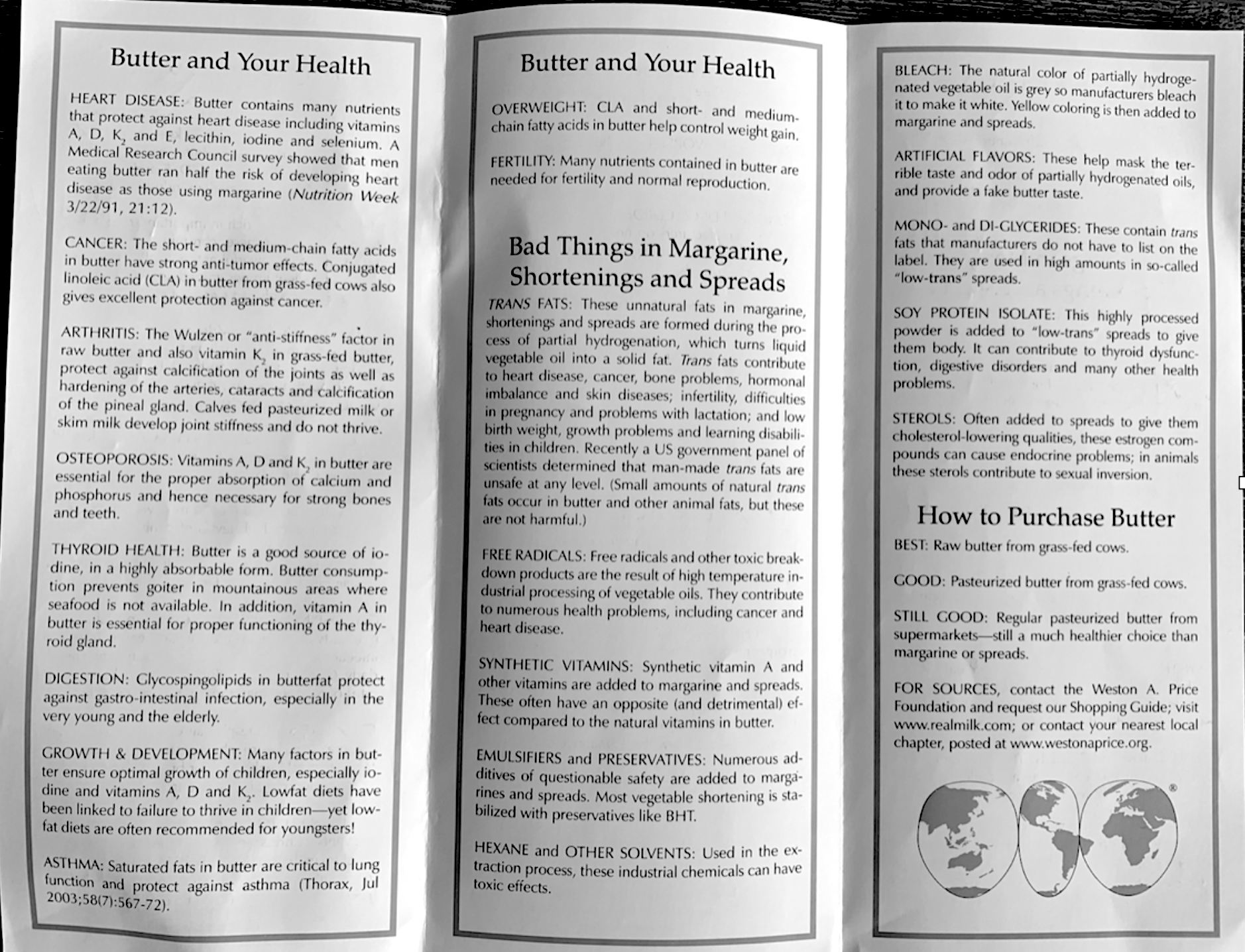
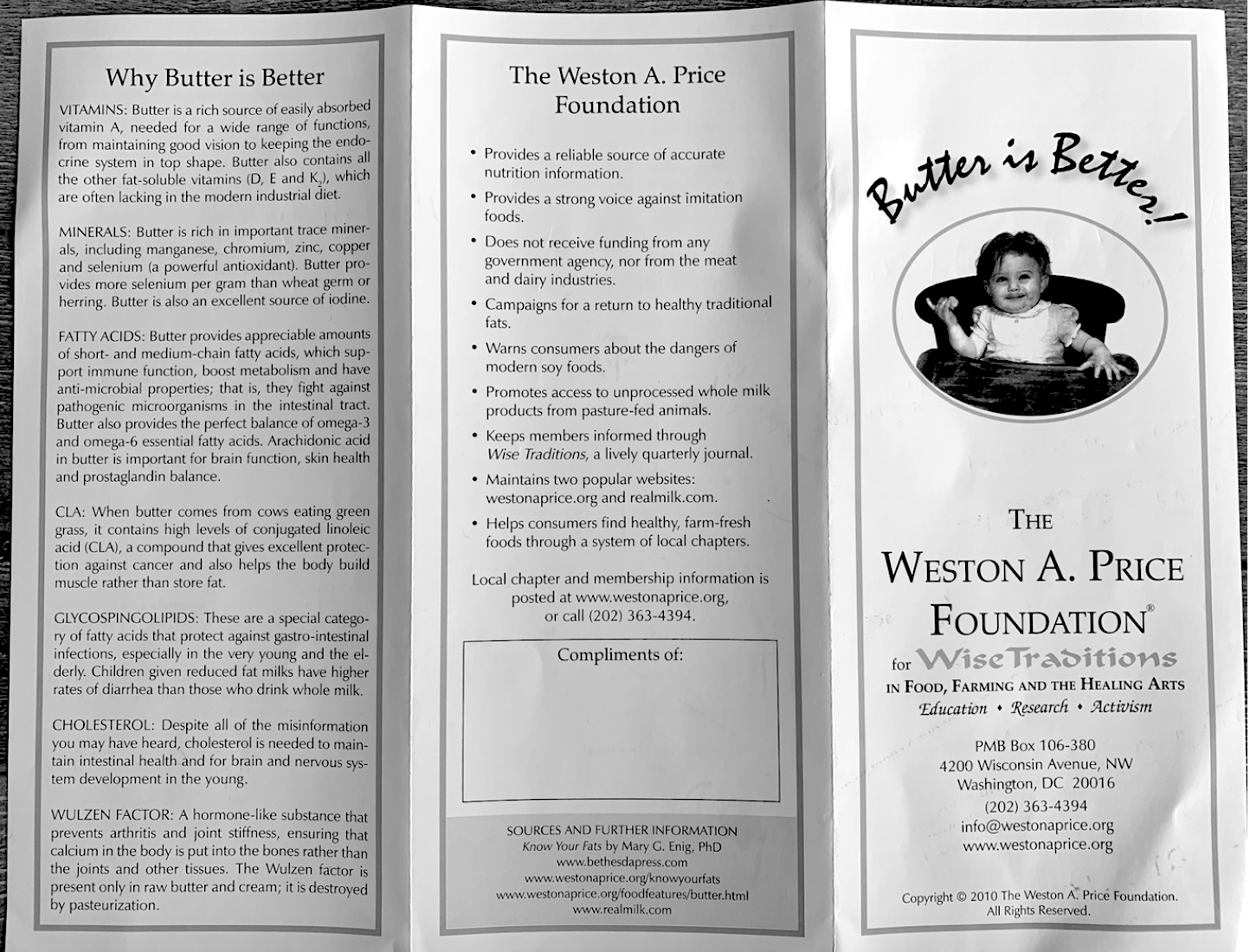
For the purpose of this article I am only concerned with butter made from the cream of cow milk as opposed to the milk of other animals and I’m only concerned with unflavoured butter as opposed to garlic, herb, or truffle infused butter. To that end I’m assuming that you have read my Red Meat due diligence blog first and have an understanding of what cows are designed to eat (grass only!!) and the factors that affect their health.
Here are the relevant questions to ask when buying butter:
1. DOES THE BUTTER CONTAIN ONLY CREAM (OR CREAM AND SALT)?
Ignore all of the marketing fluff on the front and simply read the words that come after the word “Ingredients”. The ONLY thing that butter should contain is cream, or cream and salt. That’s it. Just this one or two ingredients ONLY.
Cream is the fat that naturally rises to the top of whole milk. As any traditional wholefoodie will tell you, that’s where all the glamour is ;-) To make butter, that cream is whipped or churned until it forms into a solid called butter.
Salt is added simply to add flavour and minerals. Whether you buy salted or unsalted butter is completely your choice and comes down to personal taste. I personally prefer the taste of salted butter and appreciate the extra minerals that quality salt provides.
2. ARE THE COWS ROUTINELY 100% GRASS FED AND FREE OF HORMONES, ANTIBIOTICS AND INDUSTRIAL FEED?
This question is geared towards the quality of the cream.
As I detailed in my Red Meat due diligence blog cows are designed to eat one thing and one thing only and that is grass (pasture). The reason why grains would be fed to cows is to fatten them up but grains make cows not only fat but also sick as grains are not their natural diet. Sick cows mean sick humans who then eat the meat or dairy from those cows. Except in exceptional circumstances such as serious illness, cows should not be routinely given antibiotics and if they are their milk should be discarded and not used for human consumption.
In certain exceptional circumstances such as draught, farmers may be forced to feed their cows grains to supplement their grass diet. Hence why the question is whether the cows are routinely fed grass only as opposed to always being fed both grass and grains? Disappointingly, it is exceptionally rare in this country to find butter made from cows who are fed exclusively grass. All of the numerous butter producers I contacted in Australia except for one source their cream from dairy farmers who routinely feed their cows BOTH grass and grains. Just so you know. And while the grain that is fed to the cows only constituted a small portion (e.g. 5%) of their diet, grains are nonetheless still not the natural diet of cows. If you care about eating red meat that is 100% grass fed then I presume that you would similarly want to consume butter from cows that are also exclusively grass fed.
3. IS THE SALT UNREFINED AND FREE OF ANTI CAKING AGENTS?
This question is obviously geared towards the quality of the salt and is only relevant if you’re buying salted (as opposed to unsalted) butter.
Unrefined salt is a rich source of minerals. Given that the human body runs on vitamins and minerals, in all but limited cases of people with a very specific health condition, we SHOULD be consuming unrefined salt because of its high mineral content. By unrefined salt, I’m referring to salt in its natural unprocessed form, as opposed table salt which is highly refined, stripped of minerals, bleached, and consequentially toxic to the body.
Unrefined salt includes sea salt (e.g. Celtic sea salt, Sicilian sea salt), Himalayan salt, and Australian Murray River salt.
Many producers of salt add anti-caking agents to their salt to prevent it from caking or sticking together. Ideally, we want to avoid as many additives and unnatural ingredients as possible in the food we are eating so watch out for anti-caking agents which should be listed on the ingredients list if they are included.
Recommended brands
Based on my due diligence enquiries the butter I use both at home for my family and at Broth Bar & Larder is Australian Organic Butter by True Organics. The ingredients are only cream (green packet), or cream plus salt (orange packet). The supplier has confirmed to me in writing that the cows are 100% grass fed and only in rare drought conditions are they fed a diet of grass (95%) plus certified organic grains (5%). Drought aide, the cows are ONLY fed grass. Naturally evaporated sea salt is what they use in their salted variety. All 3 boxes ticked.
No, I do not receive any kick backs or commissions or freebies from this company or their distributor. I buy and consume it simply because it ticks my 3 due diligence questions. Period.
I opt for the salted variety in the orange coloured wrapper because I love the taste of salted butter better and everyone can do with some extra minerals. I also use the salted variety in cake recipes too (you can’t detect the taste of salt in baked goods). The only time I’ve used unsalted butter is when making ghee as that’s what the recipe called for but whether you could use salted butter to make ghee is not something I have researched but my Ayurvedic guide tells me ghee is traditionally made with unsalted butter. More on ghee later.
This butter can be purchased from most quality organic stores like Wholefoods House and The Health Emporium. I also happily sell it at Broth Bar & Larder to my health coaching clients or clients booked into the Food as Medicine public talks. Just ask my friendly customer service staff if you’re one of my health coaching clients or have booked into the Food As Medicine talks, and they will obliged you with butter (we retail it for $5.50/250g at the time of writing).
There may well be other brands that meet my due diligence enquires, but you will have to ask them and now you know the questions to ask! If you find a supplier of butter that meets these 3 due diligence questions please shoot me an email as I would be very interested to know! If a supplier isn’t readily willing to supply you with the answers to your enquiries, then that in and of itself is very telling. I provide full transparency to my customers about the provenance and processing of the food made at Broth Bar & Larder and I would expect other suppliers to be able to do the same.
What about organic certification?
Organic certification is comforting but not entirely necessary if the cows are 100% grass fed and free of hormones and antibiotics and the salt is unrefined and free of caking agents. In fact organic certification isn’t a guarantee that cows are 100% grass fed (they could be fed organic grains which is still not their natural diet). So simply because butter is certified organic does not excuse you from asking what the cows are routinely fed. Australian Organic Butter by True Organics is certified organic. If the butter is not certified organic, it is even more important to ask if the cows are fed grains and if so which grains, as non organic grains (especially corn and soy) are typically genetically modified. If you don’t have access to 100% grass fed butter, then certified organic butter that is a combo of grass and grain fed is your next best option. Butter made from raw milk that is 100% grass fed contains is your best option from a nutritional point of view, as enzymes and some nutrients are destroyed or reduced through pasteurisation BUT given it is illegal in Australia to consume raw (unpasteurised dairy) I can NOT recommend it for human consumption purposes. Though what you do it your own house is up to you. The raw (cultured) butter that is available in NSW (presumably as a cosmetic product only) is a combination of grass and grain fed. Just so you know.
What do I use butter for?
As a heat stable fat, I tend to use butter for sautéing veggies and for pan frying fish (approx. ½ - 1 tablespoon of butter per person). I also smear it on top of steamed veggies, and thickly spread it on top of quality sourdough or sprouted bread, or home made pancakes with a drizzle of pure Canadian maple syrup.
I tend to use beef tallow to fry red meat as it comes from the animal I’m cooking.
I tend to use coconut oil instead of butter when making an Asian meals or curries.
And my kids and I (and now my health coaching clients) have been known to nibble on salted butter from time to time when we feel so pulled. Yes, really. One of my favourite things that curbs hunger pangs pronto.
How much butter to consume?
As a general rule, for those without specific health issues (like an auto immune condition or who carry the APoE4 gene which means you should be mindful of reducing your saturated fat intake somewhat) you can eat as much butter as you feel comfortable eating. It’s really really really hard to overconsume butter because it is so satiating that you get your fix and fill of it super quickly, instinctively knowing when to stop. The leptin hormone is quickly released to let your body know that you’ve had your fix and fill and that there’s no need to consume any more. Let’s face it, have you known anyone to consume a whole stick of butter? If you overdo it, you tend to feel nauseous pretty quickly, though nothing seriously untoward happens.
What if you are dairy intolerant?
If you are dairy intolerant whether or not you can consume butter depends on whether your intolerance is to lactose (the milk sugars / carbohydrates) or to casein (the milk protein). Most people who are lactose intolerant do well on butter as it only contains 0.8-1% lactose so it is tolerated by all but the most lactose-sensitive individuals. If you are casein intolerant, the only dairy you can safely consume is ghee which is butter with the milk proteins (casein) removed to leave only fat.
I unpack dairy in more detail in my health coaching sessions and in my Food As Medicine public talks.
If you have an auto immune condition, dairy is strictly out, and I would put you on my auto immune meal plan (and to that end contact me for a one on one health coaching sessions for this meal plan).
A blood test or a gene test can determine if you have the APoE4 gene (and to that end see me for a list of my recommended integrative practitioners who are well versed in this area).
What about margarine?
Margarine started to be marketed many decades ago by the vegetable oil industry as a healthy alternative to butter but is anything but that. Margarine is, in a word, toxic to the human body and should be avoided at all expense. Margarine is produced by a process called hydrogenation that turns liquid vegetable oils (which are already toxic) into a solid fat (even more toxic). The resulting product contains TRANS FATS which are so toxic that in 2013 the FDA in USA determined that trans fats were no longer “Generally Recognised as Safe (GRAS)” and the Institute of Medicine determined that this is NO SAFE LEVEL OF TRANS FAT CONSUMPTION. The industry in USA must phase out trans fat by the end of 2018. Trans fats are still allowed in Australia (…why do we think that this is ok???) and are contained in not only in margarine, but in all packaged goods (especially biscuits!) that contain the ingredient “partially hydrogenated” oil.
This article is not the place to delve into the specific dangers of vegetable oils and margarine but you can read more on the attached pamphlet produced by the Weston A Price Foundation that succinctly summaries the key points.
The schematic below shows how margarine is made. Margarine is pretty much one molecule away from plastic. Experiments have shown that animals do not eat margarine because they don’t recognize it as food. Humans are the only species silly enough to eat it because of clever marketing that has confused us about what is actually real food! A good general rule of thumb is that if your great great grandmother didn’t recognize it, don’t eat it!!
What about spreadable butters?
Spreadable butter is simply butter with vegetable oils mixed into it. It falls into the same category as margarine. Avoid at all expense.
But how do I make my butter spreadable?
To make your butter easy to spread, simply leave a small amount out on the bench in a little container – enough for 1-3 days worth depending on the heat. Those school stainless steel lunchboxes with those damn missing lids make for great butter dishes!
Please ‘spread’ the word on butter vs margarine
If you know of someone who still uses margarine or spreadable butters instead of good old fashioned butter, please share this blog with them. Friends don’t let friends eat toxic foods! Your simple action of sharing this information with them can have a profound positive impact on their life. I wish I had known about the dangers of margarine and spreadable butters decades earlier. When sharing information with loved ones (gently and from a place of love – the sledgehammer approach doesn’t work- I tried it!), you are helping them lead a less toxic, more nourishing life. You then become part of a cause that is so much greater than yourself and together we can create a ripple effect that knows no bounds. What a beautiful gift to the world! If friends or family members aren’t receptive, then respect their journey and the timing of it. There is nothing stopping you from being a role model and a shiny beacon of light. YOU always have a choice.
Did you find this blog helpful?
I’d love to hear your thoughts and questions in the comments below.

